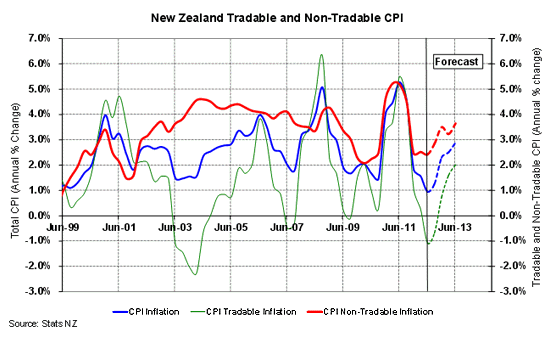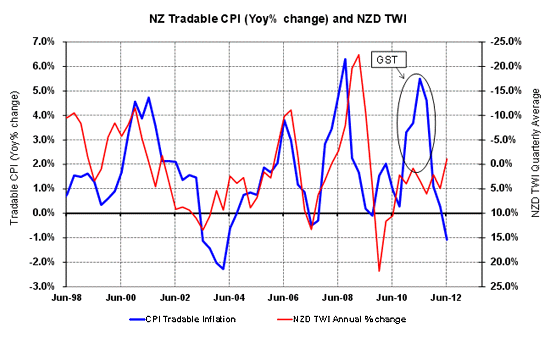
 By Roger J Kerr
By Roger J Kerr
“Still waiting for that inflation bubble, Rog?” was the smart-arse greeting I received from a competitor as I boarded a plane last Friday.
I took the comment as a compliment as it proves that he reads my column!
Looking at low historical inflation numbers and concluding that price increases will not occur in the future is a very dangerous game in my book.
Last week’s CPI figures again proved the considerable influence the NZ dollar exchange rate has over tradeable goods prices; that is, imported consumer goods.
The appreciation of the NZ dollar on a Trade Weighted Index basis over the last two years has caused material price decreases in the tradeable goods side of the inflation series.
As I have argued previously, these tradable price decreases have disguised the consistent price increases in the non-tradable category (rates, electricity, rents, building costs and insurance premiums).
Assuming that the exchange rate TWI stays stable at 72.00 over the next 12 months, the tradeable inflation is forecast to return to +0.5% increases per quarter, not repeat the decreases we have seen in recent times.
The non-tradable inflation is very sticky, averaging +0.8% per quarter increases for quite a few years now.
Add the two component parts together and the future inflation scenario is not as comfortable as the doomsayers would like you to believe (see chart).
The annual inflation rate is not going to stay at 1.0% for long based on this analysis and appears headed for 2.7% or higher 12 months forward.
Food and energy prices are on the rise again and if someone could tell me what non-tradable prices will be decreasing I would be pleased to revise the assumptions and forecasts.
Capacity utilisation is on the increase again and will increase further as the Christchurch re-build kicks in.
Capacity utilisation is historically highly correlated with non-tradable inflation.
What is really scary about the outlook for tradable inflation is if the TWI exchange rate depreciates over the next 12 months, the +0.5% per quarter forecast increase would be even higher as imported product prices increase.
The current RBNZ economic and inflation forecasts are based on the TWI depreciating from 72.00 to 68.00 over the next 12 months.
--------------------------------------------------------------------------------------------------------------------------------
To subscribe to our daily Currency Rate Sheet email, enter your email address here.
--------------------------------------------------------------------------------------------------------------------------------


-----------------------------------------------------------------------------------------------------
* Roger J Kerr runs Asia Pacific Risk Management. He specialises in fixed interest securities and is a commentator on economics and markets. More commentary and useful information on fixed interest investing can be found at rogeradvice.com
3 Comments
Roger,
We are spending every year approximately $3,500 more than we are earning for every man woman and child in the country. ($15 billion current account deficit divided by 4.3 million people).
The most pain free way to slow that down or even reverse it is for the exchange rate to depreciate. Yes, that would cause some tradeable inflation; and make NZ sourced goods and services more competitive for both our own consumption, and to sell to others.
What otherwise are the disastrous impacts of this tradeable inflation, even if it were to occur? And if not that solution to the current account, what solution do you have?
Inflation in things you need, deflation in things you want.
exactly

We welcome your comments below. If you are not already registered, please register to comment.
Remember we welcome robust, respectful and insightful debate. We don't welcome abusive or defamatory comments and will de-register those repeatedly making such comments. Our current comment policy is here.